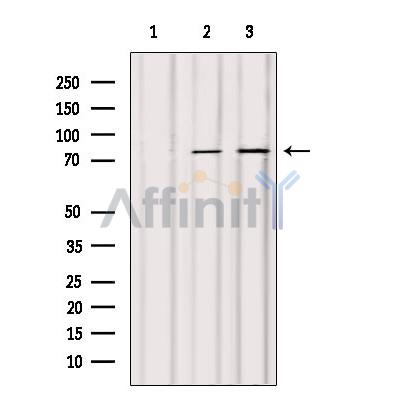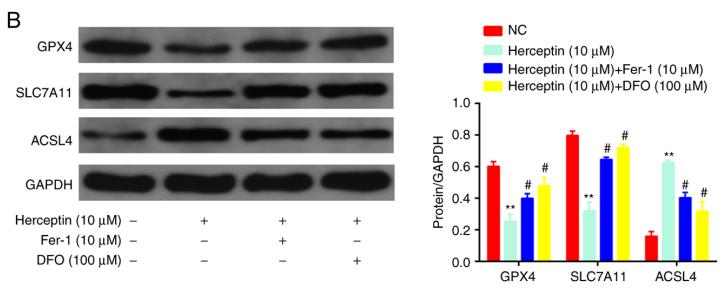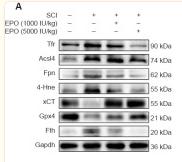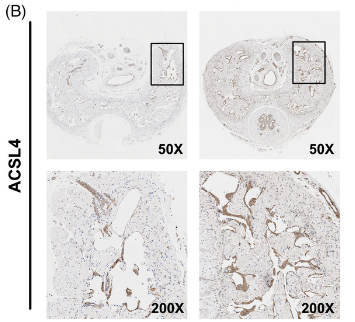产品描述
*The optimal dilutions should be determined by the end user.
*Tips:
WB: 适用于变性蛋白样本的免疫印迹检测. IHC: 适用于组织样本的石蜡(IHC-p)或冰冻(IHC-f)切片样本的免疫组化/荧光检测. IF/ICC: 适用于细胞样本的荧光检测. ELISA(peptide): 适用于抗原肽的ELISA检测.
引用格式: Affinity Biosciences Cat# DF12141, RRID:AB_2844946.
展开/折叠
ACS 4; ACS4; ACSL 4; Acsl4; ACSL4_HUMAN; acyl CoA synthetase 4; Acyl CoA synthetase long chain family member 4; FACL 4; FACL4; Fatty acid Coenzyme A ligase; fatty acid Coenzyme A ligase long-chain 4; LACS 4; LACS4; Lignoceroyl CoA synthase; Long chain 4; long chain acyl CoA synthetase 4; long chain fatty acid CoA ligase 4; long chain fatty acid Coenzyme A ligase 4; Long-chain acyl-CoA synthetase 4; Long-chain-fatty-acid--CoA ligase 4; MRX63; MRX68;
抗原和靶标
- O60488 ACSL4_HUMAN:
- Protein BLAST With
- NCBI/
- ExPASy/
- Uniprot
MKLKLNVLTIILLPVHLLITIYSALIFIPWYFLTNAKKKNAMAKRIKAKPTSDKPGSPYRSVTHFDSLAVIDIPGADTLDKLFDHAVSKFGKKDSLGTREILSEENEMQPNGKVFKKLILGNYKWMNYLEVNRRVNNFGSGLTALGLKPKNTIAIFCETRAEWMIAAQTCFKYNFPLVTLYATLGKEAVVHGLNESEASYLITSVELLESKLKTALLDISCVKHIIYVDNKAINKAEYPEGFEIHSMQSVEELGSNPENLGIPPSRPTPSDMAIVMYTSGSTGRPKGVMMHHSNLIAGMTGQCERIPGLGPKDTYIGYLPLAHVLELTAEISCFTYGCRIGYSSPLTLSDQSSKIKKGSKGDCTVLKPTLMAAVPEIMDRIYKNVMSKVQEMNYIQKTLFKIGYDYKLEQIKKGYDAPLCNLLLFKKVKALLGGNVRMMLSGGAPLSPQTHRFMNVCFCCPIGQGYGLTESCGAGTVTEVTDYTTGRVGAPLICCEIKLKDWQEGGYTINDKPNPRGEIVIGGQNISMGYFKNEEKTAEDYSVDENGQRWFCTGDIGEFHPDGCLQIIDRKKDLVKLQAGEYVSLGKVEAALKNCPLIDNICAFAKSDQSYVISFVVPNQKRLTLLAQQKGVEGTWVDICNNPAMEAEILKEIREAANAMKLERFEIPIKVRLSPEPWTPETGLVTDAFKLKRKELRNHYLKDIERMYGGK
种属预测
score>80的预测可信度较高,可尝试用于WB检测。*预测模型主要基于免疫原序列比对,结果仅作参考,不作为质保凭据。
High(score>80) Medium(80>score>50) Low(score<50) No confidence
研究背景
Catalyzes the conversion of long-chain fatty acids to their active form acyl-CoA for both synthesis of cellular lipids, and degradation via beta-oxidation. Preferentially activates arachidonate and eicosapentaenoate as substrates. Preferentially activates 8,9-EET > 14,15-EET > 5,6-EET > 11,12-EET. Modulates glucose-stimulated insulin secretion by regulating the levels of unesterified EETs (By similarity). Modulates prostaglandin E2 secretion.
Mitochondrion outer membrane>Single-pass type III membrane protein. Peroxisome membrane>Single-pass type III membrane protein. Microsome membrane>Single-pass type III membrane protein. Endoplasmic reticulum membrane>Single-pass type III membrane protein. Cell membrane.
Belongs to the ATP-dependent AMP-binding enzyme family.
研究领域
· Cellular Processes > Transport and catabolism > Peroxisome. (View pathway)
· Cellular Processes > Cell growth and death > Ferroptosis. (View pathway)
· Metabolism > Lipid metabolism > Fatty acid biosynthesis.
· Metabolism > Lipid metabolism > Fatty acid degradation.
· Metabolism > Global and overview maps > Metabolic pathways.
· Metabolism > Global and overview maps > Fatty acid metabolism.
· Organismal Systems > Endocrine system > PPAR signaling pathway.
· Organismal Systems > Endocrine system > Adipocytokine signaling pathway.
文献引用
Application: WB Species: Mouse Sample:
Application: IF/ICC Species: Human Sample:
限制条款
产品的规格、报价、验证数据请以官网为准,官网链接:www.affbiotech.com | www.affbiotech.cn(简体中文)| www.affbiotech.jp(日本語)产品的数据信息为Affinity所有,未经授权不得收集Affinity官网数据或资料用于商业用途,对抄袭产品数据的行为我们将保留诉诸法律的权利。
产品相关数据会因产品批次、产品检测情况随时调整,如您已订购该产品,请以订购时随货说明书为准,否则请以官网内容为准,官网内容有改动时恕不另行通知。
Affinity保证所销售产品均经过严格质量检测。如您购买的商品在规定时间内出现问题需要售后时,请您在Affinity官方渠道提交售后申请。产品仅供科学研究使用。不用于诊断和治疗。
产品未经授权不得转售。
Affinity Biosciences将不会对在使用我们的产品时可能发生的专利侵权或其他侵权行为负责。Affinity Biosciences, Affinity Biosciences标志和所有其他商标所有权归Affinity Biosciences LTD.






























